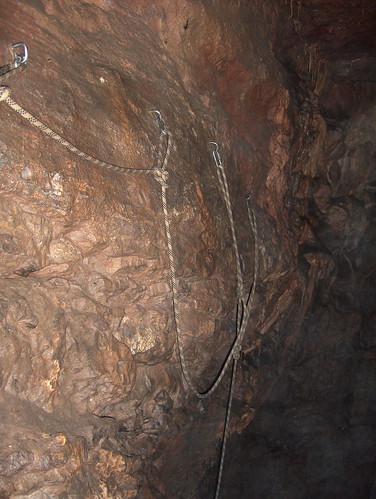Bob Mehew said:
On the back of it we wrote an article for Speleology in April 2008 whcih I will convert to a suitable form and put up on the BCA web site.
see
http://british-caving.org.uk/equipment/Cows%20Tails%20article%20v2.pdf.
Five observations on what has been written so far.
When I used the term "relaxed" I never thought people would think I was implying that knots should be so loose as to be at risk of becoming undone in a fall situation.

It has been an interesting learning point. When you dress a tied knot, you may subject it to a force of up to 0.5kN / 50kg. When you lower yourself onto a knot you then subject it to a force of around 1kN / 100kg. And in doing so, you will almost certainly tighten the knot up a little more. Lyon's report
http://www.hse.gov.uk/research/crr_pdf/2001/crr01364.pdf suggested poor rope work might place a load of 2kN / 200kg on the rope and thus the knot. The translated French Cows Tails article suggests that the maximum force a knot is likely to see under most deliberate caving action is around 3kN / 300kg. Our research work suggests a fall of even 0.5m is likely to impose a peak force of 6kN / 600 kg on the first drop rising to over 10kN / 1000kg (that is over 1 ton) for subsequent drops. We also find that the rope is most likely to break within the knot at the first bend. So by tightening a knot beyond its dressed state you are likely to increase the peak force seen in a fall situation and thus increase the likelihood of the rope breaking. By relaxing the knot I mean taking it back from 2 or more kN to 0.5kN; not leaving it at risk of undoing.

The concept of Fall Factor is almost useless for rope lengths below a few metres since the set up is not a simple single length of rope but complicated by the presence of knots, rope loops and movable metal work such as crabs, as Penguin perceptively comments. I have yet to push force measurements below 0.5m sample length but when you think about it, a crab and two knots plus their loops will take up much of that length. (Just to make clear, that 0.5m under a 1kN load, so the length prior to placing the load on the rope will be somewhat shorter.)
Drops survived is the reported parameter from dynamic testing of rope. The value of 4 mentioned by Fulk related to a brand new 9mm static rope. The Long Term Rope Test
http://british-caving.org.uk/equipment/LTRT.pdf reported the average drops survived of even lightly used caving rope at between 2 and 3 drops. The standard (BS EN 1891:1998) requires a rope to survive 5 drops.
The chances that one might seriously fall on one's cows tails or whilst abseiling or prusiking are low but the consequences could be high or even fatal, see
http://www.hse.gov.uk/research/hsl_pdf/2003/hsl03-09.pdf. I am talking about a simple precaution to reduce those consequences. Our Speleology article recommended the complete untying of the cows tails. Following some representations after the publication of that article, I backed off from suggesting a complete untying to just relaxing the knots so one can efficiently hand wash them without loosing lengths. I have found that I can get the length of a rope sample with knots when under load to within a few centimetres by simply measuring the point at which I make the second bend in the rope, having made and dressed the first knot.
The calculator at
http://www.myoan.net/climbart/climbforcecal.html gave 11.25kN for a 100kg mass on a 0.8m length static rope 0m from the last anchor (ie FF1.0) in comparison to our measurements of between 6 and 9kN. Can someone look at the coding behind the web site?




